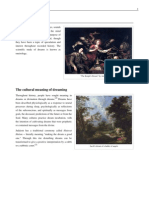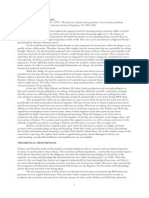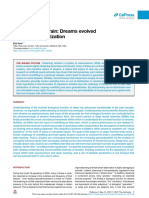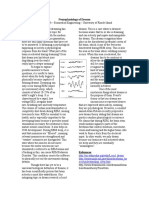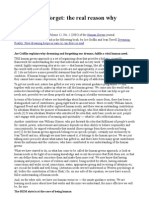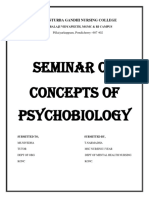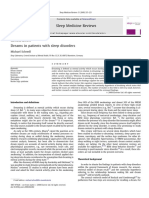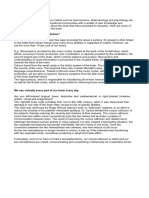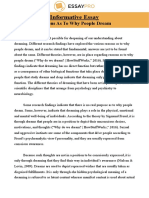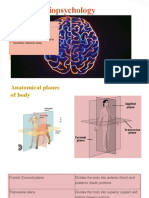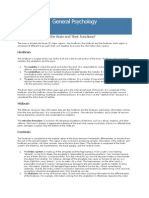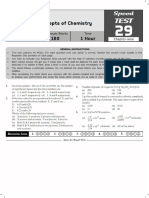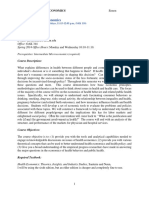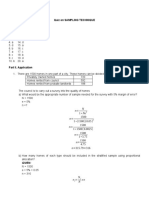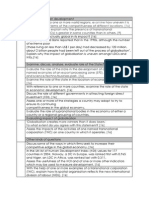Brain
Brain
Uploaded by
arushigupta06kCopyright:
Available Formats
Brain
Brain
Uploaded by
arushigupta06kOriginal Description:
Copyright
Available Formats
Share this document
Did you find this document useful?
Is this content inappropriate?
Copyright:
Available Formats
Brain
Brain
Uploaded by
arushigupta06kCopyright:
Available Formats
How the brain constructs
dreams
Abstract
Deep inside the temporal lobe of the brain, the hippocampus has a
central role in our ability to remember, imagine and dream.
Research organism: Human
Our most vivid dreams are a remarkable replication of reality,
combining disparate objects, actions and perceptions into a richly
detailed hallucinatory experience. How does our brain accomplish
this? It has long been suspected that the hippocampus contributes
to dreaming, in part due to its close association with memory:
according to one estimate, about half of all dreams contain at least
one element originating from a specific experience while the
subject was awake. Although these dreams are rarely a faithful
replication of any one memory, fragments of various recent
experiences intermingle with other memories (usually related
remote and semantic memories) to create a novel dream. Given all
this, one might guess that dreams are created by those regions of
the brain responsible for memory. However, studies dating back to
the 1960s have suggested that patients with a damaged
hippocampus still dream and, somewhat amazingly, such patients
can have dreams involving recent experiences of which they have
no conscious memory.
But are the dreams of patients with damage to hippocampus truly
‘normal’? Or alternatively, might such damage, while not
preventing dreams, alter the form in which they are expressed?
Indeed, there is reason to think that the hippocampus supports
crucial aspects of dream construction beyond the simple insertion
of memories. Recent work in the cognitive neurosciences has
established that the hippocampus, in addition to being involved in
the formation of memories, is also part of a brain system that is
involved in using memory to construct novel imagined scenarios
and simulate possible future events. As a result, patients without a
hippocampus find it difficult to imagine scenes that are coherent,
possibly because the hippocampus is responsible for combining
different elements of memory into a spatially coherent whole.
The whole brain is active during dreams, from the brain stem to
the cortex. Most dreams occur during REM (rapid eye movement)
sleep. This is part of the sleep-wake cycle and is controlled by the
reticular activating system whose circuits run from the brain stem
through the thalamus to the cortex.
The limbic system in the mid-brain deals with emotions in both
waking and dreaming and includes the amygdala, which is mostly
associated with fear and is especially active during dreams.
The cortex is responsible for the content of dreams, including the
monsters we flee from, the people we meet, or the experience of
flying. Since we are highly visual animals the visual cortex, right at
the back of the brain, is especially active, but so are many other
parts of the cortex.
Least active are some parts of the frontal lobes, and this may
explain why we can be so uncritical during dreams, accepting the
crazy events as though they are real – until we wake up.
As with many studies of rare neurological patients, the latest work
must be interpreted with caution due to the small sample size. For
example, patient dreams were not significantly shorter than control
dreams, leading to an apparently selective deficit in specific types
of details reported (such as spatial details and sensory details),
rather than a general deficit in the length of the dream. On
average, however, the control dreams contained more than twice
the number of informative words as the patient dreams, and the
lack of a statistical difference between the two groups may be a
mere artifact of the low sample size.
Nonetheless, these observations and a handful of similar studies
are helping us to understand how the hippocampus contributes to
the dreaming process. The work of Spanò et al. – who are based
at UCL, the Royal Free Hospital in London, University Hospital
Bonn and the universities of Arizona and Oxford – suggests
hippocampal damage disrupts dreaming in ways that mirror how it
also disrupts imagination. This suggests that, rather than being an
entirely distinct phenomenon, dreaming is a part of a continuum of
spontaneous, constructive thought and imagery continuously
generated across the sleep and waking states.
You might also like
- The Neurobiology of DreamingDocument12 pagesThe Neurobiology of DreamingmehrasNo ratings yet
- Dreams: Dreams Are A Succession ofDocument12 pagesDreams: Dreams Are A Succession ofNivethithaa DhanrajNo ratings yet
- (... Continued From REM Sleep & Remembering Dreams PT 1Document4 pages(... Continued From REM Sleep & Remembering Dreams PT 1nawazNo ratings yet
- Sleepless in America: Inadequate Sleep and Relationships To Health and Well-Being of Our Nation's ChildrenDocument18 pagesSleepless in America: Inadequate Sleep and Relationships To Health and Well-Being of Our Nation's ChildrenDavid SzNo ratings yet
- Read Unromancing The DreamDocument5 pagesRead Unromancing The DreamJules McConnellNo ratings yet
- Revonsuo A - The Reinterpretation of Dreams An Evolutionary Hypotesis of The Function of DreamingDocument25 pagesRevonsuo A - The Reinterpretation of Dreams An Evolutionary Hypotesis of The Function of DreamingAna LauraNo ratings yet
- Dreams: Nevertheless Continued To Dream RegularlyDocument7 pagesDreams: Nevertheless Continued To Dream RegularlyRuxandra Cristina VoineaNo ratings yet
- Overfitted Brain TheoryDocument15 pagesOverfitted Brain TheoryAndrew GarciaNo ratings yet
- A Dream Generator.Document12 pagesA Dream Generator.Caroline CunhaNo ratings yet
- Dream From Phenomenology To Neurophysiol PDFDocument8 pagesDream From Phenomenology To Neurophysiol PDFOlivier BenarrocheNo ratings yet
- DreamsfinDocument7 pagesDreamsfinMohammed KashifNo ratings yet
- Dreams, Endocannabinoids and Itinerant Dynamics in Neural NetworksDocument34 pagesDreams, Endocannabinoids and Itinerant Dynamics in Neural Networksosame kinouchiNo ratings yet
- Nir Tononi TiCS 2010 Dreaming449Document13 pagesNir Tononi TiCS 2010 Dreaming449jswzzNo ratings yet
- Frequency. Although Most People Rarely Experience Lucid Dreams, There IsDocument3 pagesFrequency. Although Most People Rarely Experience Lucid Dreams, There Issarah amalinNo ratings yet
- Are They A Product of Your Subconscious?Document15 pagesAre They A Product of Your Subconscious?Himanshu KumarNo ratings yet
- Are They A Product of Your Subconscious?Document15 pagesAre They A Product of Your Subconscious?arpana arpanaNo ratings yet
- KRIPPNER Et Al. 2000Document20 pagesKRIPPNER Et Al. 2000Ino MoxoNo ratings yet
- Deciphering Your Dreams: Reveal the mysteries of the world of dreams!From EverandDeciphering Your Dreams: Reveal the mysteries of the world of dreams!No ratings yet
- 35 DreamsDocument14 pages35 DreamsAmy AmaliaNo ratings yet
- Neurophysiology of Dreams: Sics/understanding - Sleep - HTMDocument1 pageNeurophysiology of Dreams: Sics/understanding - Sleep - HTMManayNo ratings yet
- The Enigmatic World of DreamscecDocument2 pagesThe Enigmatic World of Dreamsceclevir73505No ratings yet
- Are They A Product of Your Subconscious?Document24 pagesAre They A Product of Your Subconscious?greatNo ratings yet
- Why We Sleep - Matthew WalkerDocument107 pagesWhy We Sleep - Matthew WalkerMayur BardoliaNo ratings yet
- Dreaming To Forget - The REM State Is at The Core of Being HumanDocument12 pagesDreaming To Forget - The REM State Is at The Core of Being HumanHuman Givens Publishing OfficialNo ratings yet
- Psychology of DreamsDocument11 pagesPsychology of DreamsLokesh SharmaNo ratings yet
- By Dimitra Bella-Velidi Teacher: Zafi MandaliDocument14 pagesBy Dimitra Bella-Velidi Teacher: Zafi Mandalivishal chouhanNo ratings yet
- States of ConsciousnessDocument13 pagesStates of ConsciousnessMeerab MalikNo ratings yet
- The Mind at Night by Andrea RockDocument7 pagesThe Mind at Night by Andrea RocksimasNo ratings yet
- Chapter 5Document22 pagesChapter 5elric4608No ratings yet
- Seminar On Concepts of Psychobiology: Kasturba Gandhi Nursing CollegeDocument36 pagesSeminar On Concepts of Psychobiology: Kasturba Gandhi Nursing CollegeNarmadhaNo ratings yet
- Freudian Dream Theory Today: Summary of The TheoryDocument2 pagesFreudian Dream Theory Today: Summary of The TheoryTim HeisNo ratings yet
- Chapter 6 - States of ConsciousnessDocument56 pagesChapter 6 - States of ConsciousnessakshitaNo ratings yet
- On The Neurobiology of Hallucinations: EditorialDocument3 pagesOn The Neurobiology of Hallucinations: EditorialivanivanambrizNo ratings yet
- What Are DreamsDocument2 pagesWhat Are DreamsJohn DrabineakNo ratings yet
- Exploring Neuroscience 14-20Document7 pagesExploring Neuroscience 14-20Patricia Susckind100% (1)
- Write Up, AnkitDocument8 pagesWrite Up, AnkitAnkit VyasNo ratings yet
- Sleep, Emotions, and Visceral Control: I. N. Pigarev and M. L. PigarevaDocument12 pagesSleep, Emotions, and Visceral Control: I. N. Pigarev and M. L. PigarevaMariaNo ratings yet
- The Cognitive Neuroscience of Lucid Dreaming: Try Out and Tell Us What You Think.Document61 pagesThe Cognitive Neuroscience of Lucid Dreaming: Try Out and Tell Us What You Think.Helena QuintNo ratings yet
- Obama SpeechDocument2 pagesObama Speechapi-305909642No ratings yet
- Sleep Medicine Reviews: Michael SchredlDocument7 pagesSleep Medicine Reviews: Michael SchredlAdrienn MatheNo ratings yet
- Unit 2 - Biological Approach To BehaviourDocument27 pagesUnit 2 - Biological Approach To BehaviourMyra Jain100% (1)
- How Does The Hippocampus Affect Memory?: Limbic SystemDocument2 pagesHow Does The Hippocampus Affect Memory?: Limbic SystemAshirvad JiaswalNo ratings yet
- Mod 24 Reading AssignmentDocument3 pagesMod 24 Reading AssignmentDana M.No ratings yet
- 1 s2.0 S0149763423000738 MainDocument14 pages1 s2.0 S0149763423000738 MainKrisztián TóthNo ratings yet
- Brain Myths Resumen en-GBDocument2 pagesBrain Myths Resumen en-GBMARIA FERNANDEZNo ratings yet
- Chapter 3Document1 pageChapter 3Emilia RuedaNo ratings yet
- What Are The Parts of The Brain and Their FunctionsDocument2 pagesWhat Are The Parts of The Brain and Their FunctionskimuyyyyNo ratings yet
- What Dreams Are Made of Article QuestionsDocument5 pagesWhat Dreams Are Made of Article QuestionsChristopher MonellNo ratings yet
- Reasons As To Why People DreamDocument3 pagesReasons As To Why People DreamАзиз ЮлдашевNo ratings yet
- Brain Sciences: Olfaction-Related Factors Affecting Chemosensory Dream Content in A Sleep LaboratoryDocument20 pagesBrain Sciences: Olfaction-Related Factors Affecting Chemosensory Dream Content in A Sleep LaboratoryAftab KhuhawarNo ratings yet
- Taylor Beck, "The Twitcing Eye: REM Sleep and The Emotional Brain"Document48 pagesTaylor Beck, "The Twitcing Eye: REM Sleep and The Emotional Brain"MIT Comparative Media Studies/WritingNo ratings yet
- Why We SleepDocument6 pagesWhy We Sleepmynameisrey6No ratings yet
- Bio PsychologyDocument30 pagesBio PsychologyNEHA JUNEJANo ratings yet
- Memory N BrainDocument8 pagesMemory N Brainiqra3475No ratings yet
- (Re-) Mapping The Concept of DreamingDocument5 pages(Re-) Mapping The Concept of DreamingEduardo VLNo ratings yet
- General Psychology: What Are The Parts of The Brain and Their Functions?Document3 pagesGeneral Psychology: What Are The Parts of The Brain and Their Functions?SaraswatapalitNo ratings yet
- Academic ReadingDocument10 pagesAcademic ReadingHarpreet BhullarNo ratings yet
- El Insomnio en La Infancia PDFDocument10 pagesEl Insomnio en La Infancia PDFCarlos Perez DiazNo ratings yet
- Discover the Secrets of Lucid Dreaming: How to Use Your Dreams to Transform Your LifeFrom EverandDiscover the Secrets of Lucid Dreaming: How to Use Your Dreams to Transform Your LifeNo ratings yet
- "Unlocking the Secrets of Your Subconscious: A Guide to Understanding and Mastering Your Dreams"From Everand"Unlocking the Secrets of Your Subconscious: A Guide to Understanding and Mastering Your Dreams"No ratings yet
- Essay PcraDocument1 pageEssay Pcraarushigupta06kNo ratings yet
- Socialism in Europe and The Russian RevolutionDocument9 pagesSocialism in Europe and The Russian Revolutionarushigupta06kNo ratings yet
- There Was Once A GirlDocument2 pagesThere Was Once A Girlarushigupta06kNo ratings yet
- Untitled DesignDocument4 pagesUntitled Designarushigupta06kNo ratings yet
- Untitled DesignDocument24 pagesUntitled Designarushigupta06kNo ratings yet
- ACT Reading Tip Sheet NOTEBOOKING PDFDocument1 pageACT Reading Tip Sheet NOTEBOOKING PDFmemawrocksNo ratings yet
- Retriement Retirement - The Conclusion of A Long Journey in LifeDocument34 pagesRetriement Retirement - The Conclusion of A Long Journey in Lifeambujchinu100% (1)
- How It Works - Storwize and VMware Virtual VolumesDocument35 pagesHow It Works - Storwize and VMware Virtual VolumesaksmsaidNo ratings yet
- DLL-MATH 8 Week 1Document10 pagesDLL-MATH 8 Week 1Meljim ReyesNo ratings yet
- Paper 1 April 2020 MsDocument11 pagesPaper 1 April 2020 Msdeemahayder2000.sheNo ratings yet
- The Legend of Lake TobaDocument4 pagesThe Legend of Lake TobaLilis MahmudatunNo ratings yet
- ReferenceDocument4 pagesReferenceeswariNo ratings yet
- Cambridge IGCSE™: Mathematics 0580/31 October/November 2021Document8 pagesCambridge IGCSE™: Mathematics 0580/31 October/November 2021amos.ndhlovuNo ratings yet
- Class7 - Ode - MatlabDocument24 pagesClass7 - Ode - MatlabMohd Fauzi ZanilNo ratings yet
- Discharge System OEEDocument8 pagesDischarge System OEEamarpal07No ratings yet
- Mid Sem Dme 2021Document3 pagesMid Sem Dme 2021shreetama sahuNo ratings yet
- Professionals and Practitioners in CommunicationDocument24 pagesProfessionals and Practitioners in CommunicationDamon Chain Xerxes67% (3)
- All Autolisp CommandsDocument6 pagesAll Autolisp CommandsJay RammaNo ratings yet
- Case Study On PepsiDocument23 pagesCase Study On Pepsiadeel05232610% (1)
- Manvi Mertia - Weekly Report-1Document33 pagesManvi Mertia - Weekly Report-1Shivanshu SoniNo ratings yet
- 3451 Simon PDFDocument5 pages3451 Simon PDFEdmund ZinNo ratings yet
- Optics KitDocument1 pageOptics KitSean CampbellNo ratings yet
- FST4 10 enDocument14 pagesFST4 10 enMiguel AngelNo ratings yet
- SDH BasicsDocument72 pagesSDH Basicsk_muange897100% (1)
- Jing - Yang - Thesis - PDF Semina Paper PDFDocument220 pagesJing - Yang - Thesis - PDF Semina Paper PDFSumer ChavanNo ratings yet
- Index: S.No. Name of Practical DateDocument16 pagesIndex: S.No. Name of Practical DateAmanNo ratings yet
- Warc 100 Lessons From The Worlds Best StrategiesDocument34 pagesWarc 100 Lessons From The Worlds Best StrategiesKarthik RamanujamNo ratings yet
- NSDMERPLogs - 2023 11 25Document131 pagesNSDMERPLogs - 2023 11 25jarisahmad82No ratings yet
- Stretchable Pumps For Soft Machines PDFDocument13 pagesStretchable Pumps For Soft Machines PDFSantosh MiryalaNo ratings yet
- Introduction To Navigation in SAP Solutions On The Example of SAP S/4HANADocument28 pagesIntroduction To Navigation in SAP Solutions On The Example of SAP S/4HANAAyush Kumar100% (1)
- Point of SaleDocument15 pagesPoint of SaleSubhojit Goswamy100% (1)
- April Rose Pale Bsit-1B Quiz On Sampling Technique Part I. Multiple ChoiceDocument2 pagesApril Rose Pale Bsit-1B Quiz On Sampling Technique Part I. Multiple ChoiceSharmainne PaleNo ratings yet
- H2 Geog Essay Questions (Topical)Document3 pagesH2 Geog Essay Questions (Topical)thaddeuslzyNo ratings yet
- Secrets of SSBDocument19 pagesSecrets of SSBAtomyt0% (1)
- International Development and Engineering Associates LTDDocument12 pagesInternational Development and Engineering Associates LTDnike_y2kNo ratings yet
